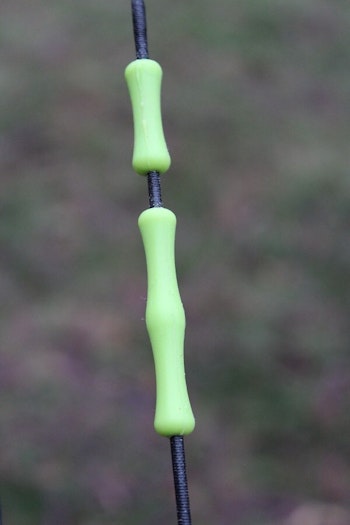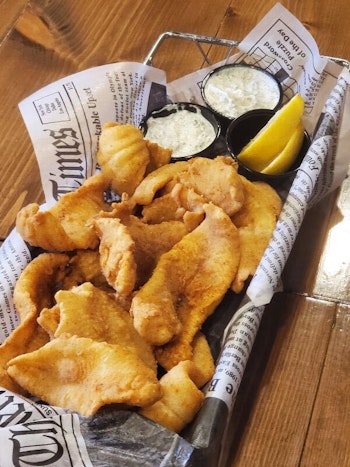
Bowfishing gear isn’t high-tech, and it’s relatively inexpensive when compared to gear for other forms of hunting. Shown above is a Cajun Bowfishing Fish Stick recurve.
Walking hip-deep in the murky water of a small river flowing swiftly near my home, I patiently wait for the glimpse of a fish in my bow-mounted spotlight. Not long into the wait I catch a glimpse of a fast-moving carp and let an arrow fly. On impact, the fish takes off downstream and the fight is on. Within a few minutes, I am holding a 13-pound grass carp.
With the carp taken to the shore and placed in the cooler, I head back to get my feet wet, and hopefully, add more fish to the cooler. This went on for a few hours that July night, and I was able to add more fish to the cooler, 16 more.
Bowfishing is unlike any other bow and arrow quests I have experienced. The action is quick, with the shots at close range — sometimes too close! I’ve had 4-foot gar swim between my legs, and there was no way I’d let an arrow fly in that situation.
Whether you’re walking the shores of a small creek, or in a boat specifically set up for bowfishing, there’s typically plenty of action. Whether it is carp, gar or other types of rough fish, the supply of these fish is abundant, and so is the action.

Bowfishing Benefits
Bowfishing helps create healthier lakes, rivers and ponds because it helps reduce the numbers of destructive fish such as the Asian carp, common carp, grass carp and buffalo. Carp and other rough fish can destroy game fish spawning beds, and harm other organisms by lowering water quality. Poor water quality can kill off species such as native freshwater mussels, which can impact the survival of anything that would eat a mussel. The slightest imbalance in the ecosystem can cause stress and death in certain species of organisms, especially microorganisms. If a species such as carp is allowed to take over a waterway, it can even damage the local fish populations to the point of no return.
Kentucky Lake was invaded by Asian carp a few years back. What was once a world-class destination for bass, crappies and other fish species was like a ghost town when it came to catching fish. Now, with the help from bow fishermen and the work done by both the Kentucky and Tennessee Departments of Conservation, the lake is on the rebound. This is just not a Kentucky Lake issue; it is happening all across America where invasive carp have taken up residence.
Bowfishing 101
Some hunters pursue wild turkeys or black bears during spring with a bow, but many simply wait until fall big game seasons to “scratch their archery itch.” Don’t wait until fall — bowfishing is fun, inexpensive and shooting opportunities come often.
You might already own a workable bow for this type of “fishing.” In the beginning, I carried an old recurve I once used for deer hunting. The retired recurve was perfect for bowfishing. It was lightweight, and I shot it instinctively. It is important to quickly pull back your bow and let an arrow fly in this fast-paced shooting. Fish rarely stay still long enough for lining up a sight pin.
Cajun Archery, Muzzy and several other companies build top-notch bowfishing bows. Just remember, you don’t need a powerful bow for most species. One with a 30- to 40-pound draw weight is typically ideal. Fish are soft compared to big game animals, and it doesn’t take a lot of power to get a pass-through shot.
When I first started bowfishing, you simply wrapped heavy bowfishing line on a spool that screwed to your bow. Those line-holders are still available today, but in my opinion a better option is buying a reel specifically designed for bowfishing. They comes in two types, a large spincast (push-button) reel that looks like one you probably started fishing with as a kid, and the second is a bottle-type reel.
For the past couple years, I’ve used the Muzzy Tournament Reel. This spincast reel is tough enough to handle the biggest of fish and is constructed to last. With a bottle-type reel, your line is stored neatly without the worry of it not being ready when needed; the most popular brands are AMS, Cajun Archery and Muzzy.

Bowfishing line must withstand the abrasions caused by rocks and other debris, as well as the strain of a fighting fish. I use 200-pound-test braided line designed specifically for bowfishing. The line’s bright color makes it easy to see in dirty water, and because it is braided the line provides strength, durability and minimal stretch.
Arrows can be relatively expensive; in my opinion, you get what you pay for. Yes, you can purchase inexpensive arrows, but they can easily break, which could result in injury. Do yourself a favor and spend the money on one or more top-notch arrows. By the time you purchase two or three inexpensive ones in a season, you could have paid for one high-quality arrow that should last for many seasons. I use a fiberglass arrow with a three-barb point. I purchased a couple earlier this spring for $24 each. At this price, you can’t afford to lose them, thus the importance of a strong bowfishing line.
When it comes to arrow points for rough fish, they are nothing like you use when hunting big game. Bowfishing points are designed not to pull back through the fish after penetrating. After getting your fish in the boat or on shore, you must twist the tip of the point, which loosens the barbs of the broadhead to be reversed and pulled back through the fish. Always be careful doing this — rarely is a shot fish dead, and they’ll flop like crazy. Don’t get hurt dealing with sharp arrow points or the fish itself.

For safety reasons, I always use an arrow equipped with a bowfishing safety slide to prevent the arrow from coming back at you if the string gets tangled during the shot. The safety slide is installed over the arrow shaft. The line is then tied to the safety slide. Always ensure the slide is near the point of your arrow before drawing back your bow.
Shooting Tips
Wear polarized sunglasses during the day to help reduce glare off the water so you can see rough fish better. Even with the correct glasses, however, the water will play tricks on you when aiming at an underwater fish.
To hit your target, you should aim at a point that seems well below the fish. In other words, the fish is actually deeper than it appears. (Underwater fish appear closer to the surface than they are because of the refraction of light.) A good rule of thumb for aiming is for every foot the fish is under the water, aim one more foot below it. This often results in a solid hit in the middle of the fish’s body.
One last word of advice is to shoot without the aid of a release; there’s just not time for it.
I prefer finger guards on the bowstring to protect my fingers through a day or night of bowfishing. I place the single finger guard above the nock and the longer guard for two fingers below the nock. Still, others put both guards below the nock. Do whatever works best for you and your aiming.
Sidebar: Muzzy Vice Bowfishing Kit
If you’re looking for a good bowfishing kit that will have everything you need to get started, then check out Muzzy. My favorite is the Muzzy Vice Bowfishing Kit (MSRP: $349.99). The bow has an adjustable draw weight of 25 to 55 pounds, with draw lengths of 24.5 to 31 inches. It will fit just about every adult. The 75 percent let-off allows you to hold the bow at full draw while waiting for a perfect shot, and it’s available in either right- or left-handed models.
The Vice Bowfishing Kit includes Muzzy’s new XD Pro Push-Button Reel, which is pre-spooled with 150-pound Tournament Test line. The reel attaches to the riser by way of an integrated stainless-steel mounting that reduces weight and allows for easy, single-bolt mounting.
The Vice Kit also includes a classic, white, 32-inch fiberglass arrow matched with the proven Muzzy Quick Release Carp Point. The arrow is held in place during the draw and release with the dependable and durable Fish Hook arrow rest.
Sidebar: Recipe: Old School-Style Fried Carp
What can you do with all these rough fish after you arrow them? They make good fertilizer for your garden, but my preferred method of disposal is to enjoy a nice meal.
I discovered this recipe for Old School-Style Fried Carp on the Missouri Department of Conservation website.
Ingredients:
- 1 pound boneless carp fillets (cut into 5-inch long pieces)
- 4 cups frying oil (vegetable or peanut oil)
- 3 cups of your preferred fish coating (Andy’s is recommended)
- 3 tablespoons Cajun seasoning (optional)
- 1-gallon zip-close bag
Instructions:
- Preheat cast-iron skillet with oil to 375 degrees.
- Combine fish coating and Cajun seasoning in 1-gallon zip-close bag.
- Drop each fillet into fish coating mixture and shake bag.
- Place fillets into hot skillet (do not overcrowd them).
- Cook 4 to 5 minutes until crispy and golden brown (should flake easily with a fork). Place cooked fillets on paper towel-lined plate.








